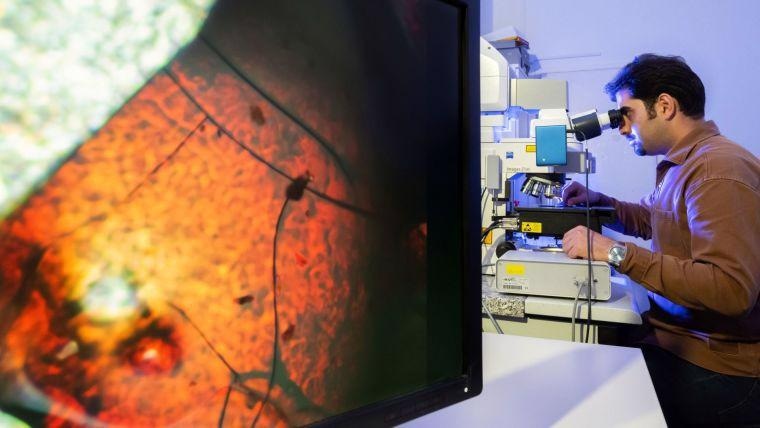Glasses are vital materials in everyday life. A key reason for this is that it is possible to manufacture glasses globally in several shapes and sizes at a low cost, using the corresponding melting techniques.
 Vahid Nozari uses a microscope to examine the new synthetic glass made of a MOF material. Image Credit: Jens Meyer (University of Jena).
Vahid Nozari uses a microscope to examine the new synthetic glass made of a MOF material. Image Credit: Jens Meyer (University of Jena).
Processing glass in a viscous state provides versatility that can hardly be obtained with other materials. However, this does not imply that it is possible to melt material from which the glass is produced in terms of its chemical composition.
The metal-organic compounds referred to as MOFs have gained more attention in recent years. Their unique characteristics make them a potential candidate for future applications like energy and environmental technology, sensor components and in the bio and life sciences.
For instance, MOFs can be employed as starting materials for filter membranes, which are used to segregate gases in technical combustion processes or for water treatment. The basis for this multiple application is the specific property of MOFs, i.e., their high and largely controllable porosity.
MOF substances comprise particles that are combined by organic molecules to form a network of pores. As MODs are mainly in powder form, an important difficulty is the mass production of components. Here, glasses play an important role.
Trade-Off Between Properties and Processability
The porosity of materials prevents them from being meltable and processable into components of the required shape, other than a few exceptions. Chemists from the Friedrich Schiller University in Jena, Germany, and the University of Cambridge, United Kingdom, have now discovered a solution to this problem. The study was published in the journal Nature Communications.
For using MOFs to produce components for industrial production, they can be processed into so-called hybrid glasses, for instance. To perform this, they must be melted, which is not a direct process considering this particular case. Thus far, only a few materials of this class have been proved as meltable.
In most known MOF materials, the high porosity is one of the reasons that — upon heating — they thermally decompose before reaching their melting point, that is, they burn.
Vahid Nozari, Doctoral Student, Laboratory of Glass Science, University of Jena
This is an interesting property that also protects them from being processed using the glass route.
Identifying Combinations of Ionic Liquids, MOF Matrices and Melting Conditions
The method to melt a non-meltable material for shaping and processing in its liquid state was discovered by a team of researchers led by Jena professor Lothar Wondraczek.
We filled the pores with an ionic liquid that stabilizes the inner surface in such a way that the substance can finally melt before it even decomposes.
Lothar Wondraczek, Lead Researcher, University of Jena
The researchers successfully demonstrated the process by which non-meltable substances from the MOF family of zeolitic imidazolate framework (ZIFs) can be melted to form a liquid state, and then into a glass.
In this way, the desired component can be obtained, for example, in the form of a membrane or a disk. Residues of the employed ionic liquid can then be washed out after shaping.
Lothar Wondraczek, Lead Researcher, University of Jena
The key to future applications is the interactions occurring between ionic liquid and the MOF material. These quantify the reversibility of the process, i.e., the possibility of washing out the auxiliary liquid post melting process.
The pore surface is not sufficiently stabilized or an irreversible chemical bond occurs between the MOF and parts of the ionic liquid due to non-adaptation of the reactions. Therefore, it is necessary to identify optimum combinations of liquids, matrix materials and melting conditions corresponding to the desired application, paving the way for large-volume objects.
Journal Reference:
Nozari, V., et al. (2021) Ionic liquid facilitated melting of the metal-organic framework ZIF-8. Nature Communications. doi.org/10.1038/s41467-021-25970-0.